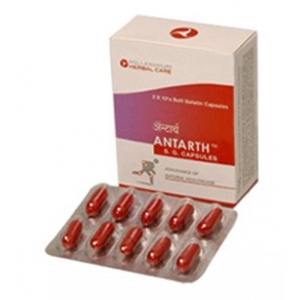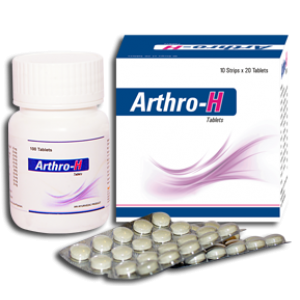Arthritis
Showing all 3 results
Arthritis is a general term used for a number of painful conditions of the joints and bones.
What is Arthritis
Arthritis is a general term used for a number of painful conditions of the joints and bones.
A joint is where two bones meet to allow movement of body parts. Arthritis literally means joint inflammation (‘arth’ : joint, ‘itis’ : inflammation). It is a chronic condition that affects ease of movements in the body. There are over 100 kinds of arthritis, pertaining to various different areas of the body. Some of the commonly
occurring ones are: Rheumatic Arthritis, osteoarthritis, ankylosing spondylitis, fibromyalgia, systemic lupus erythematosis (lupus), gout, psoriatic arthritis and Reiter’s syndrome. People of all ages, including children and young adults, can develop arthritis. There are over a 100 joints that connect the 206 bones in your body. Most joints in the body allow a pretty broad range of motion. These joints are held in place by a tough elastic material called cartilage. Cartilage acts as a shock absorber and allows the ends of the bones to glide smoothly across each other. If the cartilage is destroyed (as in osteoarthritis), the bones of that joint can grind against each other, causing severe pain, loss of mobility, deformity and dysfunction.
Every joint in your body has a small space between the bones to allow movement. This space is filled with synovial fluid that lubricates and nourishes the joint. In some forms of arthritis, this fluid and the surrounding membrane gets affected and damages the cartilage and underlying bone.
Some of the most commonly occurring forms of arthritis are:
Osteoarthritis is the most prevalent form of arthritis. The most frequently affected joints are in the hands, spine, knees and hips. Osteoarthritis mostly affects people aged between 40 and 60. It occurs due to wear and tear of joints over time. The cartilage between the bones gradually wastes away causing painful rubbing of bone on bone in the joints. It may also cause joints to fall out of their natural positions (misalignment).
Rheumatoid arthritis is a type of inflammatory arthritis. It is a chronic condition identified by pain and swelling in the joints, leading to reduction of movement, and the breakdown of bone and cartilage. Affecting between 1% and 3% of the population, it usually afflicts individuals between the ages of 30 and 50. Women are
three times more prone than men.
It is an autoimmune disease that occurs when the body’s own immune system mistakenly attacks the synovium (cell lining inside the joint). This chronic, potentially disabling disease causes pain, stiffness, swelling, and loss of function in the joints. It can affect many different joints and, in some people, other parts of the body as well,
including blood, lungs, and heart.
Ankylosing spondylitis (AS) – is a chronic inflammatory form of arthritis that affects spinal joints. The most indicative feature of Ankylosing Spondylitis is the involvement of the joints at the base of the spine where the spine joins the pelvis. It causes inflammation of the tendons and ligaments that connect and provide support to joints. Gout – Gout accounts for about 5 percent of all cases of arthritis. It is one of the most painful rheumatic diseases. It results from deposits of needle-like crystals of uric acid in the connective tissue, joint spaces, or both. These deposits lead to inflammatory arthritis, which cause swelling, redness, heat, pain, and stiffness in joints.
What causes Arthritis
The cause of rheumatoid arthritis is unknown. Pathologically, the joint lining gets inflamed and thickens up, gradually deteriorating cartilage and bone.
Rheumatoid arthritis is an auto-immune disorder. This means that the body's natural immune system does not function the way it should; it attacks healthy joint tissue, initiating a process of inflammation and joint damage. Although the reason why this happens remains elusive, recent studies have concluded that our genes play a rather important role in this.
Researchers believe, that this genetic trait, along with some other unknown factor-probably in the environment-triggers the disease.
Wear and tear of joints (due to age) can also erode the cartilage. As cartilage breaks down, the ends of the bones thicken up, and the joint may lose its normal shape, as in osteoarthritis. Further cartilage breakdown could cause the ends of the bones to rub together causing pain.
Damaged joint tissue could also trigger the release of certain substances called prostaglandins, which further contribute to pain and inflammation. Gout, on the other hand is caused by uric acid crystals forming in the joints - particularly the big toe, ankles, hands and wrists. Many individuals with rheumatoid arthritis feel that their arthritis is influenced by the weather, stress, temperature and exercise. A few have periods of remission when the disease seems to have gone away. Unfortunately, in most cases, the symptoms eventually return.
What are the symptoms of Arthritis?
Arthritis, broadly causes pain and inflammation in joints and muscles. When joints are inflamed, they get swollen, tender, and often warm to touch with slight reddening. The lubricating fluid present in between the joint, which assures a smooth motion of the joint, are also inflamed. This makes the movements painful. Along with swelling and painful joints, some of the early symptoms of the disease may include fatigue, loss of
appetite, weight loss and fever. You may experience stiffness in your joints and surrounding muscles, especially in the morning, right as you get out of bed, and could last anywhere from a few minutes to a couple of hours. Sometimes the disease involves other organs, causing damage to the heart, lungs, eyes, skin and nerves. Essentially, every type of arthritis has different symptoms.
Some of the more commonly occurring symptoms include:
• Swelling in one or more joints
• Stiffness around the joints that lasts for at least 1 hour in the early morning
• Constant or recurring pain or tenderness in a joint
• Difficulty using or moving a joint normally
• Warmth and redness in a joint
Although Arthritis is prevalent in the older population, it isn’t necessarily an age related ailment. Some forms of arthritis affect infants, while thousands of people are stricken in the prime of their lives. The one shared symptom for all these conditions is joint and musculoskeletal pain, which is why they are grouped together as ‘arthritis.’
This pain is usually a result of inflammation of the joint lining.
Symptoms of Rheumatoid Arthritis
Inflammation of the joint lining, which could lead to pain, swelling, stiffness, and loss of function.
Inflammation of tear glands, salivary glands, the lining of your heart and lungs, and the lungs themselves.
As RA progresses, about 25% of people with the disease develop small lumps of tissue under the skin, called rheumatoid nodules.
Rheumatoid nodules usually aren’t painful. They may form under the skin of the elbow, hands, the back of the scalp, over the knee, or on the feet and heels. They can be as small as a pea to as large as a walnut. But one thing is for sure – an early diagnosis may reduce the pain, joint damage, and disability that occurs in some patients.
Symptoms of Osteoarthritis
Steady or intermittent pain in a joint.
Swelling or tenderness in one or more joints. This is accompanied by stiffness after periods of inactivity, such as sleeping or sitting.
OA usually has a slow onset. Early in the disease, joints may ache after physical activity or exercise
Symptoms of Ankylosing Spondylitis
Pain and stiffness in the back. This is a result of ongoing swelling and irritation of the spinal joints (vertebrae).
In severe cases, inflammation of the vertebrae can eventually cause them to fuse together leading to severely limited mobility.
Inflammation of the tendons and ligaments that connect and provide support to joints can lead to pain and tenderness in the ribs, shoulder blades, hips, thighs, shins, heels and along the bony points of the spine.
Symptoms of Gout
During initial onset, there may be a gradual build up of crystals without noticeable symptoms.
As crystals build up, there is considerable swelling of joints. The joints are also warm to touch.
Gout pain is very severe and prolonged.
How is arthritis diagnosed?
If you have persistent discomfort and swelling in multiple joints on both sides of your body, make an appointment to see your doctor. Early intervention can ensure that you receive the right diagnosis and help you to start feeling better, sooner. Early intervention can also help prevent irreversible joint damage.
Diagnosing rheumatic diseases can be challenging because certain signs and symptoms are common to many different diseases. The doctor might need to see the patient more than once to make an accurate diagnosis. The first step of diagnosis, is to elicit a detailed and complete medical history of the patient. This includes looking into the patients family history for arthritis or any rheumatic diseases, to rule out or confirm a
correlation, if any.
Secondly, one needs to probe into the onset of pain and other symptoms, by asking questions such as –
– How and when did the pain start?
– When does the pain occur?
– Does activity make the pain better or worse?.. etc.
Physical Examination
The doctor will examine the patient’s joints and spine for redness, warmth, damage, ease of movement, and
tenderness. To see what the joint looks like inside, the doctor might order x-rays or other imaging procedures.
X rays provide an image of the bones, but they do not show cartilage, muscles, and ligaments.
Other noninvasive imaging methods such as computed tomography (CT or CAT scan), magnetic resonance imaging (MRI), and arthrography show the whole joint.
The doctor may look for damage to a joint by using an arthroscope, a small, flexible tube which is inserted through a small incision at the joint and which transmits the image of the inside of a joint to a video screen. If your physician is still uncertain about the diagnosis or suspects that you may have an infection, he may perform Joint aspiration (A procedure in which the surgeon withdraws and examines the synovial fluid from
affected joints using a needle).
Because some forms of arthritis can affect other organs, a complete physical examination that includes the heart, lungs, abdomen, nervous system, eyes, ears, and throat may be necessary.
The doctor may order some laboratory tests to help confirm a diagnosis.
If the blood test shows presence of an antibody called rheumatoid factor, then it is possible that the person has Rheumatoid arthritis. However, it is also possible to have the rheumatoid factor in your blood and not have RA.
Gout can be detected by the presence of elevated uric acid levels in blood. In addition to this, gout may also be
confirmed by examining fluid sample from the joint for the presence of urate crystals.




